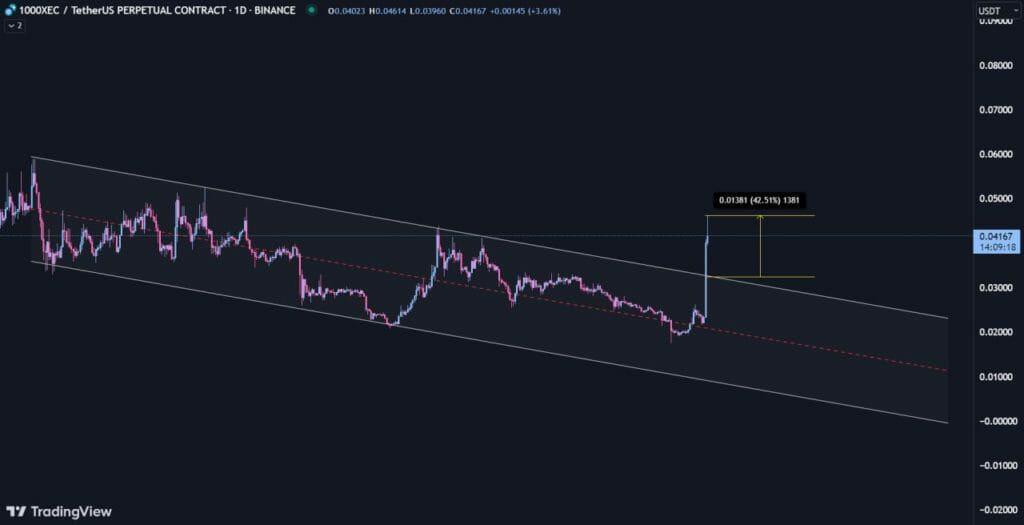Cryptocurrencies are often touted as the future of money, but how many are used as a medium of exchange? Most of them need to be more volatile, slow, or complex to be adopted by the masses. However, one crypto aims to change that: XEC coin.
XEC coin is the native token of eCash, a rebranded version of Bitcoin Cash ABC, a fork of Bitcoin and Bitcoin Cash. eCash claims to be a “cryptocurrency that’s designed to be used as electronic cash.” In this article, we will explore the origins, price journey, current price analysis, and future of XEC coin, as well as its live price and performance today.
Live XEC Price Analysis
XEC coin is trading at around $0.000044 with a market cap of $848 million and a 24h trading volume of $1.1billion.
XEC coin is up by 83% in the last 24 hours, which is higher than the average crypto market performance in general.
Let’s have a look at the chart for trend analysis:

It was consolidating from long time in parallel channel, hence broke it which caused it to pump.
Origins
XEC coin was launched on July 1, 2021, due to a hard fork and rebranding of Bitcoin Cash ABC (BCHA). BCHA was created in November 2020, when Bitcoin Cash (BCH) split into two chains: BCHN and BCHA. BCHN followed the original roadmap of BCH, while BCHA introduced a controversial feature called the Infrastructure Funding Plan (IFP), which allocated 8% of the block rewards to a development fund.
BCHA faced low adoption and support from the community and several attacks from malicious miners. In an attempt to revive the project and differentiate itself from BCH, BCHA rebranded to eCash and implemented several changes, such as:
- A redenomination of 1:1,000,000 ratio, meaning that 1 million BCHA became 1 XEC.
- A new base unit, “bits,” replaced the unwieldy decimal places of BCHA. For example, instead of sending 0.00001000 BCHA, you would send 10 bits with XEC.
- A proof-of-stake (PoS) consensus layer called “Avalanche,” which improved the security and scalability of the network.
- A new difficulty adjustment algorithm called “ASERT,” which stabilized the block times and reduced the variance of mining rewards.
- A roadmap that includes subchains, fractional satoshis, staking rewards, and smart contracts.
Price Journey
XEC coin started trading at around $0.00003 on July 1, 2021, after the hard fork and rebranding. It quickly gained momentum and reached an all-time high of $0.0005926 on November 10, 2021, representing a staggering increase of nearly 20,000% in just four months. This was driven by several factors, such as:
- The successful launch and adoption of eCash and its features.
- Listing XEC on major exchanges such as Binance, OKEx, Bitrue, and Bybit.
- The endorsement of XEC by prominent figures in the crypto space, such as Roger Ver, the CEO of Bitcoin.com and a vocal supporter of BCH.
- The increased demand for cryptocurrencies that offer fast, cheap, and easy transactions.
However, XEC coin also faced several challenges and setbacks along the way, such as:
- The volatility and uncertainty of the crypto market in general affected most cryptocurrencies’ prices.
- The regulatory crackdown on crypto in the United States and other countries created fear and doubt among investors.
- The competition from other cryptocurrencies that offer similar or better features than eCash, such as Bitcoin (BTC), Ethereum (ETH), Solana (SOL), Cardano (ADA), Polygon (MATIC), etc.
Future
The future of XEC coin depends mainly on the development and adoption of eCash and its features. eCash has a roadmap that includes several ambitious and innovative goals, such as:
Subchains: A layer-2 scaling solution that allows for parallel processing of transactions on different subchains, increasing the throughput and efficiency of the network.
Fractional satoshis: A feature allowing smaller units of XEC coin than bits, enabling microtransactions and lower fees.
Staking rewards: A feature that allows users to stake their XEC coins and earn passive income from transaction fees and inflation.
Smart contracts: A feature that enables programmable logic and functionality on eCash, allowing for decentralized applications (DApps) and other use cases.
If eCash can successfully implement these features and attract more users and developers to its platform, it could increase the demand and value of XEC coin. However, eCash also faces several challenges and risks, such as:
Competition: eCash is not the only cryptocurrency that aims to be used as electronic cash. It competes with other cryptocurrencies that offer similar or better features, such as Bitcoin (BTC), Ethereum (ETH), Solana (SOL), Cardano (ADA), Polygon (MATIC), etc.
Regulation: eCash is subject to the regulatory environment of different countries and jurisdictions, which could affect its adoption and legality. For example, eCash is currently facing a lawsuit from the SEC in the United States, which could have a negative impact on its reputation and price.
Security: eCash relies on a proof-of-work (PoW) consensus mechanism for its main chain, making it vulnerable to attacks from malicious miners with more than 51% of the network’s hash power. Although eCash has implemented a proof-of-stake (PoS) layer called “Avalanche” to improve its security, it is still not proven to be immune to attacks.
For on-demand analysis on any cryptocurrency, join our Telegram channel.








